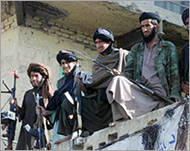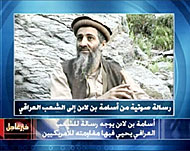Al-Qaida: Enemy of the States
Although al-Qaida is an organisation reviled or hailed across the world, its exact nature remains a mystery to most.

The shadowy group rose from the ranks of Arab volunteers who flocked to Afghanistan to fight Soviet invaders in the early 1980s.
Afghanistan had become a hot front in the Cold war contest between the Soviet Union, which had sent troops at the end of the 1970s to defend a friendly Marxist dictatorship, and the United States, which backed increasingly religious-minded rebels.
Among those flocking to support the rebel Afghans was wealthy Saudi business owner Usama bin Ladin. He formed a group of Islamist fighters, or mujahidin, dedicated to the overthrow of what they saw as a Godless regime.
The US and Saudi governments were keen to ensure the mujahidin succeeded. Many analysts believe bin Ladin himself received training, and financial and military support, from the CIA, assisted by the intelligence services of neighbouring Pakistan.
This axis of convenience achieved its aim, tying down more than 120,000 Soviet troops for a decade before the exhausted and bloodied occupying army withdrew in 1989.
Changing targets
In the 1990s, the US left war-ravaged Afghanistan and focused on other countries in the Middle East, such as Iraq. Left largely to their own devices as world attention drifted away, the mujahidin factions fell to fighting among themselves.
 |
|
Mujahidin of the Taliban army – |
After 1996, the puritanical Taliban faction – backed by Saudi Arabia and Pakistan – became the dominant force in the country.
Having helped to expel one non-Muslim alien power, bin Ladin’s group – al-Qaida, meaning the Base or Foundation – set its sights on a different enemy.
It began targeting the only remaining superpower with troops and dependent governments in the region: its former backer, the US.
Bin Ladin believes only by breaking Washington’s dominant influence in the Middle East and other parts of the Muslim world, can the West’s puppet regimes be toppled and replaced with what he regards as legitimate governments.
And only once these corrupt, un-Islamic regimes have been swept away, can Muslims come together to form one strong, independent Islamic bloc, he claims. Among the illegitimate Arab governments targeted for destruction were the Saudi and other Gulf monarchies, plus those in Egypt and Saddam Hussein’s Iraq.
The Bush administration was quick to blame the spectacular 11 September 2001 attacks on al-Qaida and identified 19 suspects. But scant hard evidence has been provided for the allegations and bin Ladin has never conclusively admitted responsibility although he has praised the attacks.
Nebulous network
Once a defined body of battle-hardened fighters and operatives, al-Qaida began to draw in other groups of fighters and dissidents with its aggressive Islamist ideology aimed at challenging the world order.
|
Key attacks linked 7 August 1998 US embassies in Tanzania and Kenya bombed, 231 including 12 Americans die. |
It thus became a network of organisations and cells in different countries with loose links to the cadres around bin Ladin himself.
Some argue it has become more of an idea, around which disparate armed groups have rallied, than anything else.
Among those with suspected links to al-Qaida are Ansar al-Islam (allegedly present in Iraq and other Middle East states) the GIA (Armed Islamic Group) in Algeria, the Abu Sayyaf rebel group in the Philippines, and the Islamic Movement of Uzbekistan.
A faction of the Islamic Jihad group in Egypt is believed to have merged with al-Qaida. Its leader, Ayman al-Zawahiri, has become one of bin Ladin’s chief lieutenants and allegedly the mastermind behind its biggest operations.
Other key al-Qaida figures include Shaikh Said, bin Ladin’s brother-in-law and believed to be al-Qaida’s financial controller, and Saif al-Adil, an Egyptian reported to be bin Ladin’s security chief.
Critics of US policy, however, say the Bush administration and its allies have been too quick to declare a link between al-Qaida and any group or government Washington deems an enemy.
They note US officials have persuasively linked Saddam Hussein to al-Qaida in the minds of the US public even though most analysts and even Senate inquiries have dismissed the idea of any meaningful connection.
Dead or alive
The Taliban provided bin Ladin’s group with a haven until the US military campaign of late 2001 to topple the regime.
 |
|
Bin Ladin’s network is still active |
The US operation is believed to have disrupted and displaced the core around bin Ladin, with some followers finding refuge in neighbouring countries such as Pakistan.
But continuing clashes in Afghanistan and attacks linked to al-Qaida in Saudi Arabia and elsewhere suggest Bush’s War on Terror remains far from achieving its declared aim.
Moreover, US claims that al-Qaida operatives are active in Iraq are ironic, given the generally accepted view that bin Ladin’s network failed to make much headway under Saddam Hussein’s rule.
The organisation is now thought to operate in 40 to 50 countries, not only in the Middle East and Asia but in North America and Europe.
Meanwhile, the al-Qaida leader – whom President George Bush declared was “wanted dead or alive” – remains at large despite the deployment of significant ground forces in Afghanistan and sophisticated surveillance technology to track him down.
White House officials have sought to play down the importance of his capture, while some commentators have periodically claimed that bin Ladin has been killed. He is known to suffer from kidney problems and reportedly requires dialysis treatment.
But a continuing series of taped messages containing topical references suggest the al-Qaida chief remains alive though his exact whereabouts are a mystery.